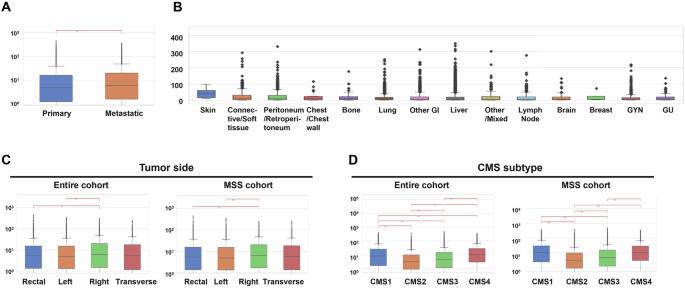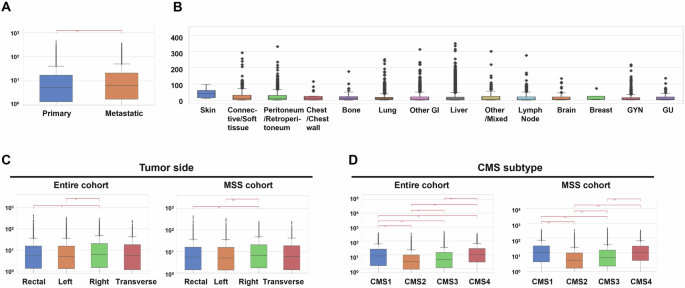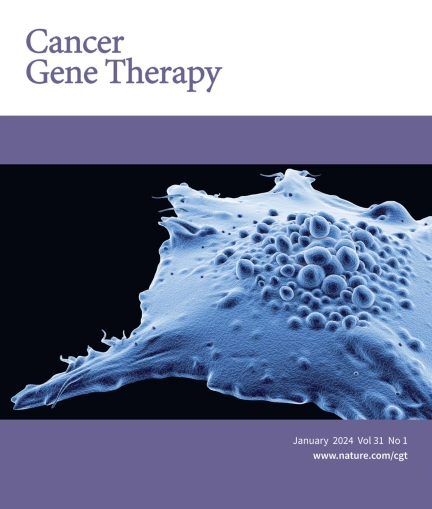Mesothelin expression correlates with elevated inhibitory immune activity in patients with colorectal cancer
IF 4.8
3区 医学
Q1 BIOTECHNOLOGY & APPLIED MICROBIOLOGY
引用次数: 0
Abstract
The expression of the protein Mesothelin (MSLN) is highly variable in several malignancies, including colorectal cancer (CRC), and high levels are associated with aggressive clinicopathological features and worse patient survival. Colorectal cancer is both a common and deadly cancer; being the third most common in incidence and second most common cause of cancer-related death. While systemic therapy remains the primary therapeutic option for most patients with stage IV (metastatic; m) CRC, their disease eventually becomes treatment refractory, and 85% succumb within 5 years. Microsatellite-stable (MSS) CRC tumors, which constitute more than 90% of patients with mCRC, are generally refractory to immunotherapeutic interventions. In our current work, we characterize MSLN levels in CRC, specifically correlating expression with clinical outcomes in relevant CRC subtypes, and explore how MSLN expression impacts the status of immune activation and suppression in the peritumoral microenvironment. Higher MSLN expression is prevalent in CMS1 and CMS4 CRC subtypes and correlates with higher gene mutation rates across the patient cohorts. Further, MSLN-high patients exhibit increased M1/M2 macrophage infiltration, PD-L1 staining, immune-inhibitory gene expression, enrichment in inflammatory, TGF-β, IL6/JAK/STAT3, IL2/STAT5 signaling pathways, and mutation in KRAS and FBXW7. Together, these results suggest that MSLN protein is a potential target for antigen-specific therapy and supports investigation into its tumorigenic effects to identify possible therapeutic interventions for patients with high MSLN expressing MSS CRC.


间皮素的表达与结直肠癌患者抑制性免疫活性的升高有关。
在包括结直肠癌(CRC)在内的几种恶性肿瘤中,间皮素蛋白(MSLN)的表达变化很大,高水平的间皮素蛋白与侵袭性临床病理特征和较差的患者生存率有关。结直肠癌是一种既常见又致命的癌症,发病率位居第三,是癌症相关死亡的第二大常见原因。虽然全身治疗仍是大多数 IV 期(转移性;m)CRC 患者的主要治疗选择,但他们的疾病最终会变得难治,85% 的患者会在 5 年内死亡。微卫星稳定型(MSS)CRC 肿瘤占 mCRC 患者的 90% 以上,通常对免疫治疗干预无效。在目前的工作中,我们描述了 CRC 中 MSLN 水平的特征,特别是将其表达与相关 CRC 亚型的临床结果联系起来,并探索 MSLN 的表达如何影响瘤周微环境中的免疫激活和抑制状态。CMS1和CMS4 CRC亚型中普遍存在较高的MSLN表达,并与患者队列中较高的基因突变率相关。此外,MSLN高的患者表现出更高的M1/M2巨噬细胞浸润、PD-L1染色、免疫抑制基因表达、富集于炎症、TGF-β、IL6/JAK/STAT3、IL2/STAT5信号通路以及KRAS和FBXW7突变。这些结果表明,MSLN蛋白是抗原特异性治疗的潜在靶点,并支持对其致瘤效应进行研究,以确定对MSLN高表达MSS CRC患者可能的治疗干预措施。
本文章由计算机程序翻译,如有差异,请以英文原文为准。
求助全文
约1分钟内获得全文
求助全文
来源期刊

Cancer gene therapy
医学-生物工程与应用微生物
CiteScore
10.20
自引率
0.00%
发文量
150
审稿时长
4-8 weeks
期刊介绍:
Cancer Gene Therapy is the essential gene and cellular therapy resource for cancer researchers and clinicians, keeping readers up to date with the latest developments in gene and cellular therapies for cancer. The journal publishes original laboratory and clinical research papers, case reports and review articles. Publication topics include RNAi approaches, drug resistance, hematopoietic progenitor cell gene transfer, cancer stem cells, cellular therapies, homologous recombination, ribozyme technology, antisense technology, tumor immunotherapy and tumor suppressors, translational research, cancer therapy, gene delivery systems (viral and non-viral), anti-gene therapy (antisense, siRNA & ribozymes), apoptosis; mechanisms and therapies, vaccine development, immunology and immunotherapy, DNA synthesis and repair.
Cancer Gene Therapy publishes the results of laboratory investigations, preclinical studies, and clinical trials in the field of gene transfer/gene therapy and cellular therapies as applied to cancer research. Types of articles published include original research articles; case reports; brief communications; review articles in the main fields of drug resistance/sensitivity, gene therapy, cellular therapy, tumor suppressor and anti-oncogene therapy, cytokine/tumor immunotherapy, etc.; industry perspectives; and letters to the editor.
 求助内容:
求助内容: 应助结果提醒方式:
应助结果提醒方式:


